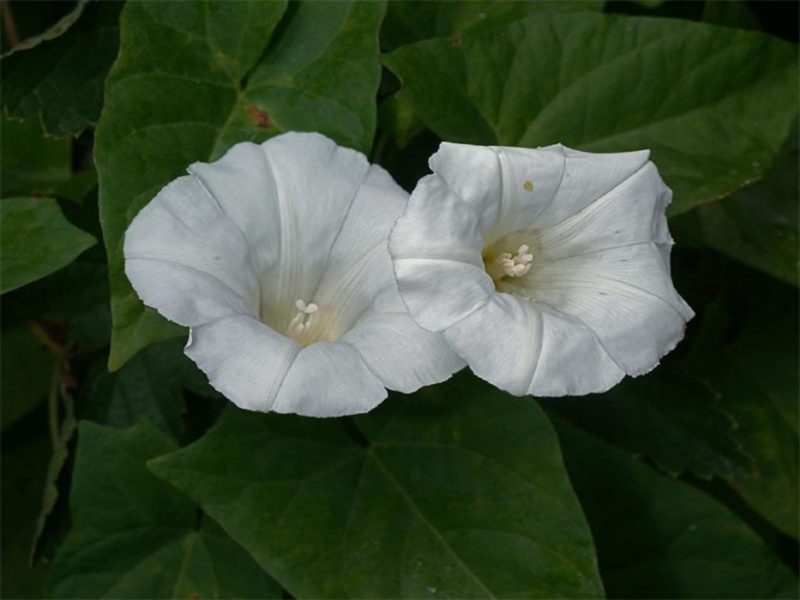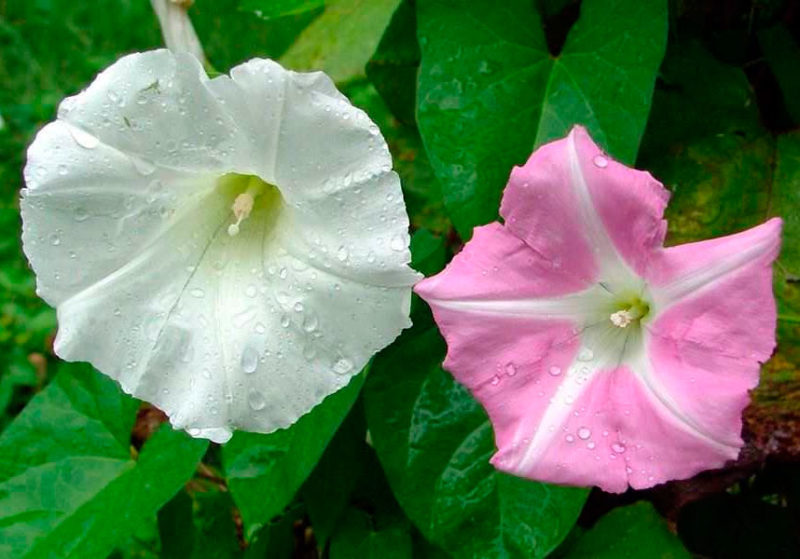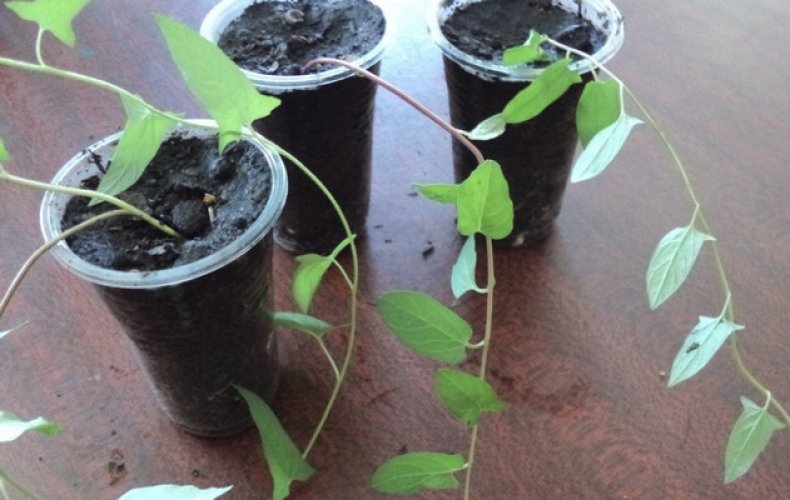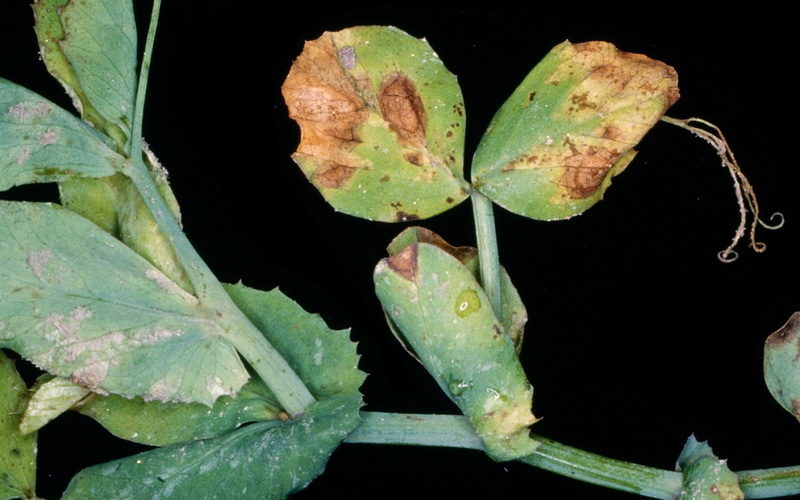Field bindweed or plow fence is a well-known weed, which is very difficult to get rid of. But few know that he has a wonderful relative - Calistegia, capable of perfectly decorating a fence or arch.
Material Content:
Description of the types of flowers
The genus Calistegia (Calystegia) belongs to the family of bindweed. The flower, introduced into the culture, really looks like the next of kin, but its dimensions are slightly larger:
- longer are regular, triangular, sharp at the end leaves located on elongated petioles;
- above - up to 3 cm bracts;
- larger bell-shaped or terry buds - up to 9 cm.
 Their color, unlike wild species, can be not only white or pink, but almost scarlet. Only the roots have not changed. They are the same cord-like and creeping. Starting in June or early July, the plant looks very decorative thanks to the numerous flowers located singly in the axils of the leaves.
Their color, unlike wild species, can be not only white or pink, but almost scarlet. Only the roots have not changed. They are the same cord-like and creeping. Starting in June or early July, the plant looks very decorative thanks to the numerous flowers located singly in the axils of the leaves.
Closer to autumn, they become smaller, but flowering continues until the frosts. Terry kalistegiya gives a lot of basal shoots. This plant is a long-liver, therefore it can exist in one place for up to 10 years.
In the culture of species there are few:
- Calistegia is fluffy. She came to us from China. It differs in the length of curly shoots - up to 4 m. Flowers can be simple and terry. Varieties are few, the most famous calistegia is Flora captivity (Flore plena). Its large up to 9 cm buds with a subtle aroma are surprisingly similar to miniature soft pink roses. For a barely noticeable fluff covering the leaves, it is called fluffy.
- Calistegia is coniferous. The shoots are not too long - only up to 2 meters. Terry flowers have a white color with a slight pinkish tint.
- Calistegia is hybrid.View with a medium-length stalk and large double flowers with a pinkish tint. Very decorative.
- Calistegia Daurian. The shoots are long, pubescent foliage. The buds, although not terry, are very large. Scarlet color prevails in their shade.
Preparation for landing
The biggest problem is to find seedlings of this so far rare plant in our gardens. Usually they are sold in peat pots, since this culture does not tolerate drying out of the root system and can die. When choosing a future pet, you need to pay attention to its healthy appearance. When buying at rest, only the roots can be examined - the grassy ground part dies in the winter.
The plant is quite unpretentious, but in order to please it with decorativeness, a number of conditions must be met:
- choose a well-lit area for planting - it also grows in partial shade, but it blooms not so abundantly;
- make sure that moisture does not collect at the landing site, and groundwater lies deep;
- the soil should be light in mechanical composition and contain a lot of nutrients;
- for deep digging contribute 1 sq. km. m bucket of compost or humus, as well as 2 tbsp. l full mineral fertilizer. It is good to add 1 glass of ash;
- it is a liana, because it needs support immediately when planting, since the shoots quickly leave the ground in spring and are growing rapidly;
- planting calistegia is better to transfer to spring; a planted plant in autumn may not survive the winter.

She does not tolerate the neighbors next to her and ruthlessly destroys them, drowning in numerous shoots.
This aggressive plant needs to limit the area of growth using plastic or slate sheets dug to a depth of at least 40 cm.
Outdoor planting
The cuttings are located at a distance of 35 cm from each other. It must be borne in mind that they are growing rapidly. At the bottom of the dug pit, drainage is laid. The planting mixture for dusting the roots is prepared from turf soil, humus and sand with the addition of a small amount of ash.
 The roots of callistegi are neatly straightened at the bottom of the planting pit and sprinkled with prepared soil, deepening by 15 cm. Watering after the events is mandatory.
The roots of callistegi are neatly straightened at the bottom of the planting pit and sprinkled with prepared soil, deepening by 15 cm. Watering after the events is mandatory.
Calistegia care on site
Due to its unpretentiousness and aggressiveness, Calistegia tolerates well the complete lack of care, requiring only a little shelter for the winter. But in order for it to fully show its decorativeness, it needs to be fed and watered.
Irrigation is rare if there is no rain. Calistegia is easier to survive a little drought than waterlogging. Organic fertilizers are used for feeding (infusion of mullein in a proportion of 1:10, a liter of infusion per bucket of water), alternating them with complex art. l per 1 square. m landings.
Frequency of top dressing every 10-15 days. Loosen the plants carefully - the roots are easy to damage.
During the growing season, faded inflorescences are removed. In winter, shoots are cut to the root. Only the landing of this year needs warming. It is enough to sprinkle them with dry leaves or sawdust. In the spring, shelter is removed.
Breeding methods
Non-terry varieties of this bindweed can be propagated by seeds. Terry forms do not produce such material and propagate vegetatively. The best time to divide rhizomes is May. But if necessary, you can arrange this in the fall, not forgetting to cover the newly formed landing.
 For reproduction, you need to cut off part of the root that grows horizontally. It should have shoots or sleeping buds. The technology for planting layering is the same as for an adult plant.
For reproduction, you need to cut off part of the root that grows horizontally. It should have shoots or sleeping buds. The technology for planting layering is the same as for an adult plant.
Pest and Disease Control
Most often, plants that undergo waterlogging suffer from ailments. Rot, root decay, powdery mildew are fungal in nature. To combat them using copper-containing fungicides or biological fungicide "Fitosporin". With prolonged rainy weather, you should not wait for the onset of the disease, it is better to carry out preventive treatment.

The most common pests are slugs and snails. Parasites can deprive the plant of decorativeness by nibbling the buds. They are protected by a non-toxic Thunderstorm. Against the spider mite, the insect-acacaricide "Actellic" is effective.
Use in garden decoration
Vertical gardening is the main purpose of Calistegia in the garden. Pergolas, pergolas, arches, pyramids and columns are places where the flower will look original and will show itself in all its glory. The culture will hide under an dense veil of stems and leaves any unsightly fence or structure. The main thing is that she should cling to, and the height of the support should not exceed 2 meters.











